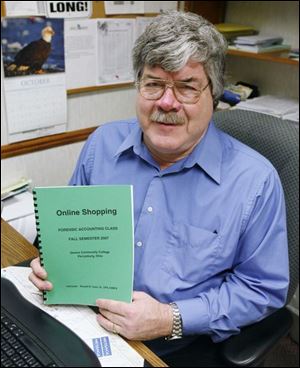
Tips help to shop, purchase carefully and avoid online scams
1/2/2008
Ronald Coon, an adjunct instructor of accounting at Owens Community College, displays the guide that he and his class put together on how to avoid getting involved in Internet scams.
The Internet can be hazardous to your finances, as anyone who receives spam probably knows. Fraudsters and crooks abound, many of them clever.
Now, an instructor and his accounting class at Owens Community College have produced a guide to online shopping intended to make cyberspace safer for consumers.
The 46-page guide, Online Shopping, which will be put on the college's Web site, describes the scams out there and offers tips for recognizing and avoiding them.
"It's for people to read, enjoy, and learn from," said Ronald Coon, a certified public accountant who has been an adjunct instructor of accounting at Owens for almost 20 years.
His fall forensic accounting class put Online Shopping together in part as a community service, he said.
The guide discusses all kinds of online scams, from well-known ones such as the Nigerian letter to the more arcane 809 area-code flimflam that lures a caller to claim a prize by calling a number that can cost $25 per minute.
Mr. Coon gives full credit to his students for coming up with the idea for the guide and doing the legwork and writing.
When the idea was proposed, he liked it right away, not least because a dear friend of his was caught in a certified-check scam.
In this kind of a hustle, a scammer sends a "certified check" for more than is owed, say, for an online auction purchase on condition that the victim deposit the check and wire the scammer the difference. The check, of course, bounces.
"The biggest reason this scam draws numerous people in is because the scammer appears to have sent you what appears to be the equivalent of real money, usually in the form of a cashier's check drawn on a U.S. bank, a postal money order, or certified check " the guide explains.
" The predator relies on the victim's belief that real cashier's checks, certified checks, and postal money orders can be trusted more than personal checks.
In some cases, the counterfeit checks or money orders that the scammers send are so real-looking that they can even fool a bank teller and are very, very tough to identify as fake," the guide continues.
The Federal Trade Commission reported receiving more than 176,000 complaints in 2006 relating to Internet fraud.
More than $590 million was paid by consumers reporting the fraud, with the median loss being about $500.
Credit cards were the most common form of payment (35 percent), followed by wire transfer (22 percent), and bank account debit (18 percent). In 45 percent of complaints, the initial contact was by e-mail.
Why do so many people fall victim to the scam?
"Count on greed to overrule common sense," Mr. Coon said. "I'm the first to preach common sense."
David Shaffer, one of Mr. Coon's students, noted that secure, reputable Web sites tend to have a certification with a seal of approval from a company such as VeriSign.
"Those certifications show the safety of the site," he explained. The guide includes the certification logos.
Mr. Coon said he'd like to make a hard copy of the guide available in the Owens' bookstore as well.
"It was a fun project, and worthwhile," he said. "When the final draft was in, we critiqued it together. There was an atmosphere of teamwork throughout the whole process."
Contact Carl Ryan at
carlryan@theblade.com
or 419-206-0356.